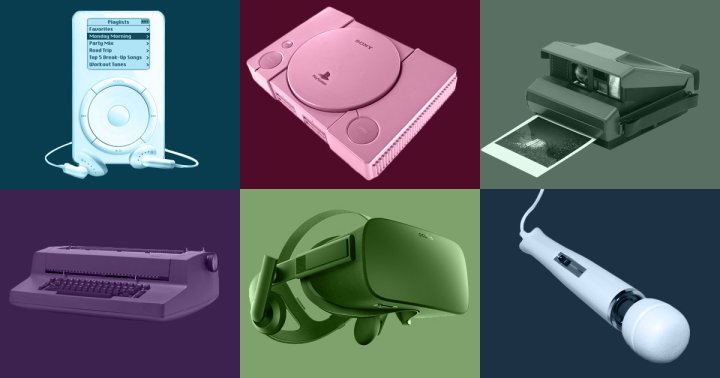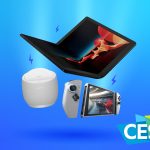Think of the gear you can’t live without: The smartphone you constantly check. The camera that goes with you on every vacation. The TV that serves as a portal to binge-watching and -gaming. Each owes its influence to one model that changed the course of technology for good.
It’s those devices we’re recognizing in this list of the 50 most influential gadgets of all time.
Some of these, like Sony’s Walkman, were the first of their kind. Others, such as the iPod, propelled an existing idea into the mainstream. Some were unsuccessful commercially, but influential nonetheless. And a few represent exciting but unproven new concepts (looking at you Oculus Rift).
Rather than rank technologies—writing, electricity, and so on—we chose to rank gadgets, the devices by with consumers let the future creep into their present. The list—which is ordered by influence—was assembled and deliberated on at (extreme) length by TIME’s technology and business editors, writers and reporters. What did we miss?
(Read TIME’s affiliate link policy.)
Google Glass Prescriptions
John Minchillo—AP
Google Glass
Google Glass, which cost $1,500 for those invited to a sort of public beta test, never took off. The relatively powerful head-mounted computer provided important signals for the future of wearable technology. Glass showed that designers working on computing devices that are worn face a different set of assumptions and challenges. Glass, for example, made it easy for users to surreptitiously record video, which led some restaurants, bars and movie theaters to ban the device. Glass also showed the potential pitfalls of easily identifiable wearables, perhaps best proven by the coining of the term “Glassholes” for its early adopters. While Glass was officially shelved in 2015, augmented reality—displaying computer-generated images over the real world—is a concept many companies are still trying to perfect. Google included.
Makerbot Industries LLC Replicator 2 Desktop 3D Printer
Victor J. Blue—Bloomberg/Getty Images
Makerbot Replicator
The Makerbot Replicator was neither the first nor the best consumer-level 3-D printer. But it was the model that made the technology widely accessible for the first time, thanks to its sub-$2,000 price tag. The Replicator used inkjet printer-like technology to extrude hot plastic that took three-dimensional form as artwork, mechanical parts and more. As a company, Makerbot’s future is uncertain. But the firm’s equipment helped bring 3-D printing into the mainstream and is a fixture of many American classrooms.
segway
David LeFranc—Gamma-Rapho/Getty Images
Segway
Why is the Segway personal scooter such a potent cultural symbol? Maybe it has something to do with providing a metaphor for increasingly out-of-shape Americans. Perhaps it was seeing a U.S. president fall off one. Weird Al’s “White and Nerdy” video helped, too. The Segway—as hyped and as mocked as it has been—is a defining example of “last mile” transportation, an electric scooter designed to make walking obsolete. (Recently, the idea has been somewhat revived by the emergence of so-called hover boards, which are now also entering a kind of post-fad twilight.) The Segway’s symbolic impact greatly exceeded its commercial success. Unit sales never exceeded the six-figure mark before the firm was purchased by a Chinese interest in 2015 for an undisclosed sum.
Yamaha Clavinova Digital Piano
You could argue the Minimoog did far more for music tech, or that the Fairlight was cooler, but visit average U.S. households from the 1980s forward and you’re most likely to encounter the Clavinova. Yamaha’s popular digital piano married the look and compactness of a spinet (a smaller, shorter upright piano) with the modern qualities of a modest synthesizer. With a plausibly pianistic weighted action and space-saving footprint, it’s become a staple for parents looking to bring maintenance-free musicality—you never have to tune it—into households, all without sacrificing huge swathes of living space.
DJI Phantom 3 Professional
Kiyoshi Ota—Bloomberg/Getty Images
DJI Phantom
Small drones may soon be delivering our packages, recording our family get-togethers and helping first responders find people trapped in a disaster. For now, they’re largely playthings for hobbyists and videographers. Chinese firm DJI makes the world’s most popular, the Phantom lineup. Its latest iteration, the Phantom 4, uses so-called computer vision to see and avoid obstacles without human intervention. That makes it easier for rookie pilots to fly one, making drones more accessible than ever.
Raspberry Pi Product Shoot
Olly Curtis—Future Publishing/Getty Images
Raspberry Pi
The Raspberry Pi is a single-board computer with a price tag to match its tiny size: about $35, without a monitor, mouse or keyboard. Not meant to replace everyday computers, the Pi is being used in classrooms worldwide to help students learn programming skills. With eight million Pi’s sold as of last year, the odds are decent that the next Mark Zuckerberg will have gotten his or her start tinkering with one.
nest thermostat
Nest
Nest Thermostat
Developed by the “godfather of the iPod,” Tony Fadell, the Nest Learning Thermostat was the first smart home device to capture mass market interest following its launch in 2011. Pairing the iconic round shape of classic thermostats with a full-color display and Apple-like software, the Nest features considerable processing power. (For instance, its ability to use machine learning to detect and predict usage patterns for heating and cooling a home.) As interesting as the device itself is, the Nest thermostat really turned heads in 2014 when the company behind it was bought by Google for $3.2 billion. The search engine giant turned the device into the center of its smart home strategy with hopes of ushering in an age of interconnected devices that will make everyday living more efficient.
Osborne 1 portable microcomputer, c 1981.
Science & Society Picture Library/Getty Images
Osborne 1
When you think of a portable computer, the Osborne 1 is probably not what comes to mind. But this unwieldy 25-pound machine was heralded by technology critics at the time of its 1981 release—BYTE magazine celebrated that it “fit under an airline seat.” The Osborne’s limitations, like a screen about the size of a modern iPhone’s, kept sales low. The machine’s true influence wasn’t on future gadgets, so much as how they are marketed. The company’s executives had an unfortunate knack for prematurely announcing new products, leading would-be customers to hold off for the better version and thus depressing sales. Marketing students now learn to avoid this deleterious “the Osborne effect.”
Fitbit Alta
Dave Kotinsky—Getty Images
Fitbit
Pedometers have been around for centuries (seriously, look it up), but it was Fitbit that helped bring them into the digital age and to the masses. The company’s first device, released in 2009, tracked users’ steps, calories burned and sleep patterns. Most importantly, it allowed users to easily upload all that data to the company’s website for ongoing analysis, encouragement or guilt. Priced at $99, the Fitbit showed that wearables could be affordable. The company sold more than 20 million of the devices in 2015.
roku
Kirk McKoy—LA Times/Getty Images
Roku Netflix Player
An inexpensive upstart running Linux, Roku’s hockey-puck sized Netflix-and-more video streaming box emerged out of nowhere in 2010 to rally waves of cord-cutters who cancelled their cable. What its chunky remote lacked in features, the box more than made up for in software. While at first Apple struggled to rationalize its comparably barren Apple TV-verse, Roku was offering thousands of channels and the most partnerships with the biggest players.
sony-discman-d50
Sony Discman D-50
Following up on the success of the Walkman, Sony unveiled this portable CD player in 1984, just a year after the music industry adopted the format. The device and later portable CD players helped the compact disc usurp cassettes as the dominant music format in the United States in less than a decade.
oculus rift
Oculus/AP
Oculus Rift
2016’s Oculus Rift virtual reality headset could wind up a total flop and we’d still grant Oculus a special place in computing history. And not just because Facebook paid $2 billion for the device’s parent company foreseeing a future of social interaction and virtual vacationing provided by VR. Whatever happens next, the Rift, along with ebullient creator Palmer Luckey, will be remembered for reinvigorating the notion of strapping awkward-looking things to our faces in trade for the privilege of visiting persuasively real imaginary places.
apple ibook
Reuters
Apple iBook
The iBook’s brightly-colored, plastic trim may look dated now, but it was the first laptop to offer wireless networking. Apple’s consumer-oriented portable—for its cool-factor as well as its technology—grew into a serious business. The product’s reveal was a classic example of Steve Jobs’ showmanship at its best. While loading a webpage and showing off the computer’s display at 1999’s MacWorld conference, the Apple co-founder lifted the computer off its table and walked across the stage. The crowd roared in approval. In a gesture, he showed that Wi-Fi was here to stay.
A 1984 Motorola DynaTAC 8000X, the world’s first commerciall
Tim Boyle—Bloomberg/Getty Images
Motorola Dynatac 8000x
Motorola’s Dynatac 8000x was the first truly portable cellphone when it launched in 1984. Marty Cooper, an engineer with Motorola at the time, first demonstrated the technology by making what’s regarded as the first public cellular phone call from a New York City sidewalk in 1973. (It was both a PR stunt and an epic humblebrag: Cooper called his biggest rival at AT&T.) The Dynatac 8000x weighed nearly two pounds and cost almost $4,000.
PalmPilot palmtop computer, c 1998.
Science & Society Picture Library/Getty Images
Palm Pilot
The original Palm Pilot 1000 solidified handheld computing when it launched in 1996, paving the way for BlackBerry and, eventually, today’s smartphone. The “palm top” computer (get it?) came with a monochrome touchscreen that supported handwriting and was capable of syncing data like contacts and calendar entries to users’ computers. It spawned a device category known as the “personal digital assistant,” or PDA. It wasn’t the first such device—the Apple Newton preceded it—but it was the first one people wanted and bought in droves.
hp deskjet
James Looker—MacFormat Magazine/Getty Images
HP DeskJet
Obsoleting noisy, lousy dot matrix technology, devices like 1988’s HP DeskJet gave computer owners the ability to quietly output graphics and text at a rate of two pages per minute. The DeskJet wasn’t the first inkjet on the market, but with a $995 price tag, it was the first one many home PC users bought. Over the 20 years following the product’s launch, HP sold more than 240 million printers in the DeskJet product line, outputting Christmas letters, household budgets, and book reports by the millions. Even in an increasingly paper-less world, the inkjet’s technology lives on in 3-D printers, which are fundamentally the same devices, only extruding molten plastic instead of dye.
Nokia 3210 / Handy
Ullstein Bild—Getty Images
Nokia 3210
For many, Nokia’s colorful candy bar-shaped 3210 defined the cell phone after it was released in 1999. With more than 160 million sold, it became a bestseller for the Finnish company. The 3210 did more than just introduce the cellphone to new audiences. It also established a few important precedents. The 3210 is regarded to be the first phone with an internal antenna and the first to come with games like Snake preloaded. Gadget reviewers even praised the phone more than 10 years after its launch for its long battery life and clear reception.
jerrold-cable-box
Jerrold
Jerrold Cable Box
True story: Cable TV was already a thing in the 1950s. Sure, it took Ted Turner in the 1970s and channels like MTV in the 1980s for what we think of as cable TV’s halcyon days to emerge. But decades earlier, the first commercial cable box that would inspire so many others was an unassuming wood-paneled console manufactured by Pennsylvanian company Jerrold Electronics, sporting three-way sliders for dozens of different channels.
Nintendo Unveils Wii Game device
Robert Gilhooly—Bloomberg
Wii
“Thanks to Nintendo’s Satoru Iwata, we’re all gamers now,” went the headline of Wired’s obituary for Nintendo’s beloved president, who died last July. Nothing speaks to Iwata’s legacy more than the company’s game-changing Wii (pun intended). Nintendo’s tiny pearl-white box, released in 2006, and which users engaged with motion control wands, had moms and dads and grandpas and grandmas out of their seats and swinging virtual golf clubs or dancing. No game system has done more to illustrate the omni-generational appeal of interactive entertainment.
sony playstation
Jesse Wild—Edge Magazine/Getty Images
Sony PlayStation
You’d be hard pressed to name a single PlayStation feature that by itself transformed the games industry. It’s been Sony’s obsession with compacting high-end tech into sleek, affordable boxes, then making all that power readily accessible to developers, that’s made the PlayStation family an enduring icon of the living room. Part of Sony’s triumph was simply reading the demographic tea leaves: The company marketed the PlayStation as a game system for grownups to the kids who’d literally grown up playing Atari and Nintendo games. And that helped drive the original system, released in 1994, to meteoric sales, including the PlayStation 2’s Guinness record for bestselling console of all time—a record even Nintendo’s Wii hasn’t come close to breaking.
A Toshiba HD-A30 HD DVD player with 1080p resolution is shown at a news conference at the CES in Las Vegas
Rick Wilking —Reuters
Toshiba DVD Player
Electronics manufacturers were already fiddling with standalone optical storage in the early 1990s, but the first to market was Toshiba’s SD-3000 DVD player in November 1996. Obsoleting noisy, tangle-prone magnetic tape (as well as the binary of “original” versus “copy”) the DVD player made it possible to watch crisp digital movies off a tiny platter just 12 centimeters in diameter—still the de facto size for mainstream optical media (like Blu-ray) today.
tivo
TiVo, Inc/AP
TiVo
“How much would you pay never to see another talking frog or battery-powered bunny again?” this magazine asked when the first TiVo was announced in 1999. The box, called a “Personal Video Recorder” at the time, is the forerunner to today’s DVRs. TiVo owners could record shows picked from a digital menu (no more confusing VCR settings) and pause or rewind live television. Much to TV execs’ consternation, the TiVo let viewers of recorded programming breeze past commercials. That the TiVo made it easier than ever to record a TV show gave rise to “time-shifting,” or the phenomenon of viewers watching content when it fits their schedule.
Amazon Kindle
Mel Melcon—LA Times/Getty Images
Amazon Kindle
Amazon began as an online bookstore, so it’s no surprise that its most influential piece of hardware changed the way we read. The Kindle quickly took over the e-reader market, becoming the best-selling product in the history of Amazon.com in 2010. Follow-up hardware ventures, such as the Kindle Fire Tablet and Echo home assistant, have also found success. The Kindle also marks the beginning of Amazon’s evolution as a digital media company. Today the company has digital stores for music, movies and video games in addition to books.
Polaroid camera
Stephen Oliver, Dorling Kindersley—Getty Images
Polaroid Camera
Millennials get plenty of flak over their penchant for instant gratification. But that’s a desire that crosses generations. Need proof? When the first affordable, easy-to-use instant shooter, the Polaroid OneStep Land camera, hit the market in 1977, it quickly became the country’s best-selling camera, years before “Millennials” were a thing. That Polaroid photographs so dominated 80s-era family albums and pop culture gives the square-framed, often off-color snaps a retro appeal that today is celebrated by enthusiasts and aped by billion-dollar apps like Instagram.
Commodore 64 microcomputer, c 1985.
Science & Society Picture Library—Getty Images
Commodore 64
Commodore’s 8-bit brown and taupe lo-fi 1982 masterpiece ranks with record-keeper Guinness as the best-selling single computer in history. No surprise, as the chunky, relatively affordable keyboard-housed system—users plugged the whole thing into a TV with an RF box—did more to popularize the idea of the personal home computer than any device since. And it promised to make you more popular, too: “My friends are knockin’ down my door, to get into my Commodore 64,” sang a Ronnie James Dio clone in a power-metal ad spot.
iPad 2
Dan Pearce—Future Publishing/Getty Images
Apple iPad
The iPad’s 2010 launch spurred a slew of headlines questioning whether or not the tablet would replace the laptop as the most important personal computer. Apple’s iPad wasn’t the first tablet, but it was radically different from what came before. Earlier devices, like the GriDPad and Palm Pilot, had smaller touchscreens users had to operate with a stylus. Microsoft unveiled a tablet that ran Windows XP in 2002. The problem, however, was that these devices didn’t have interfaces that were well-suited for touch, and they were often clunkier and larger than the iPad. Apple sold 300,000 iPads on its first day in stores, roughly matching the iPhone’s day-one numbers, and has gone on to dominate the market.



